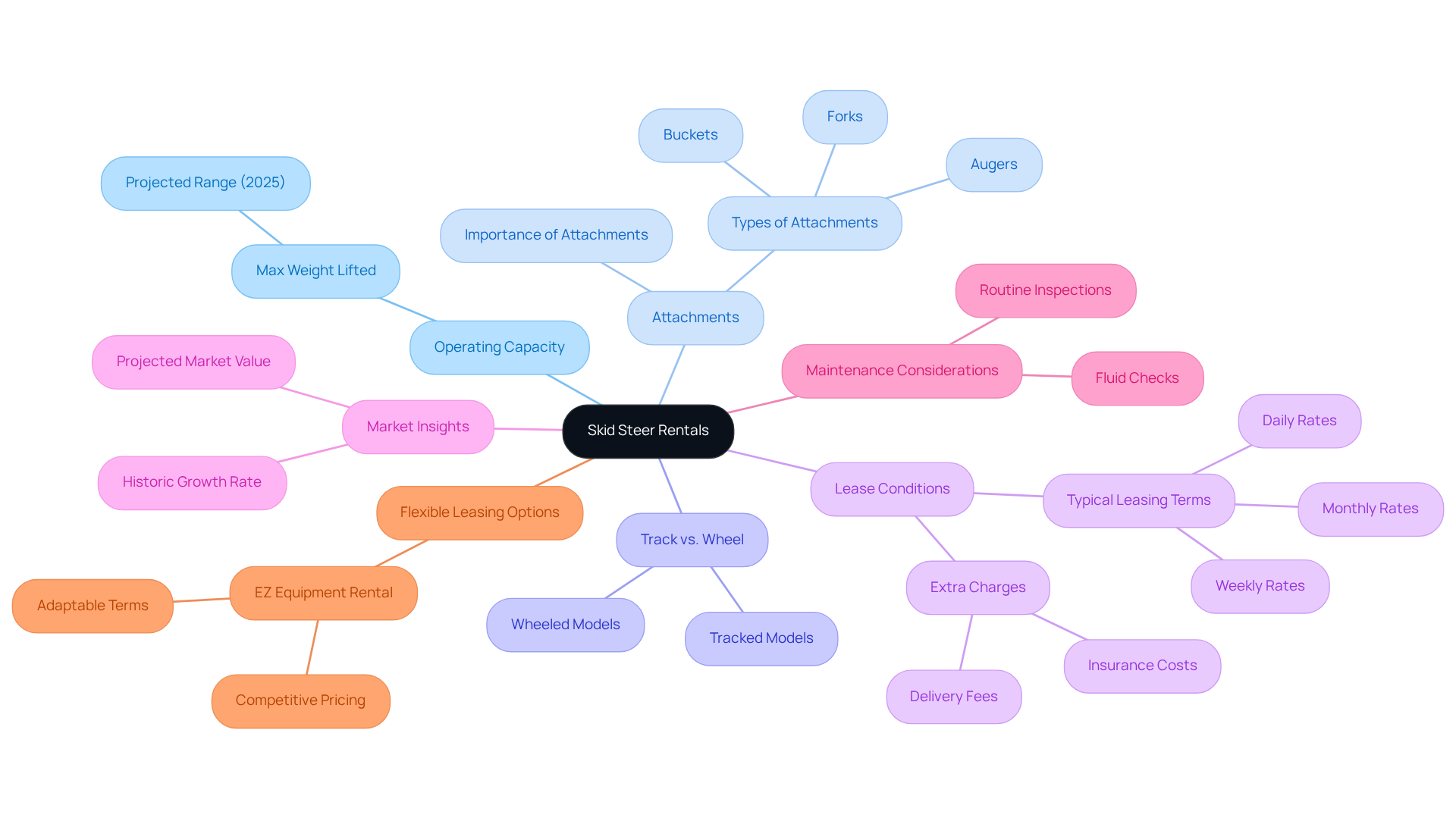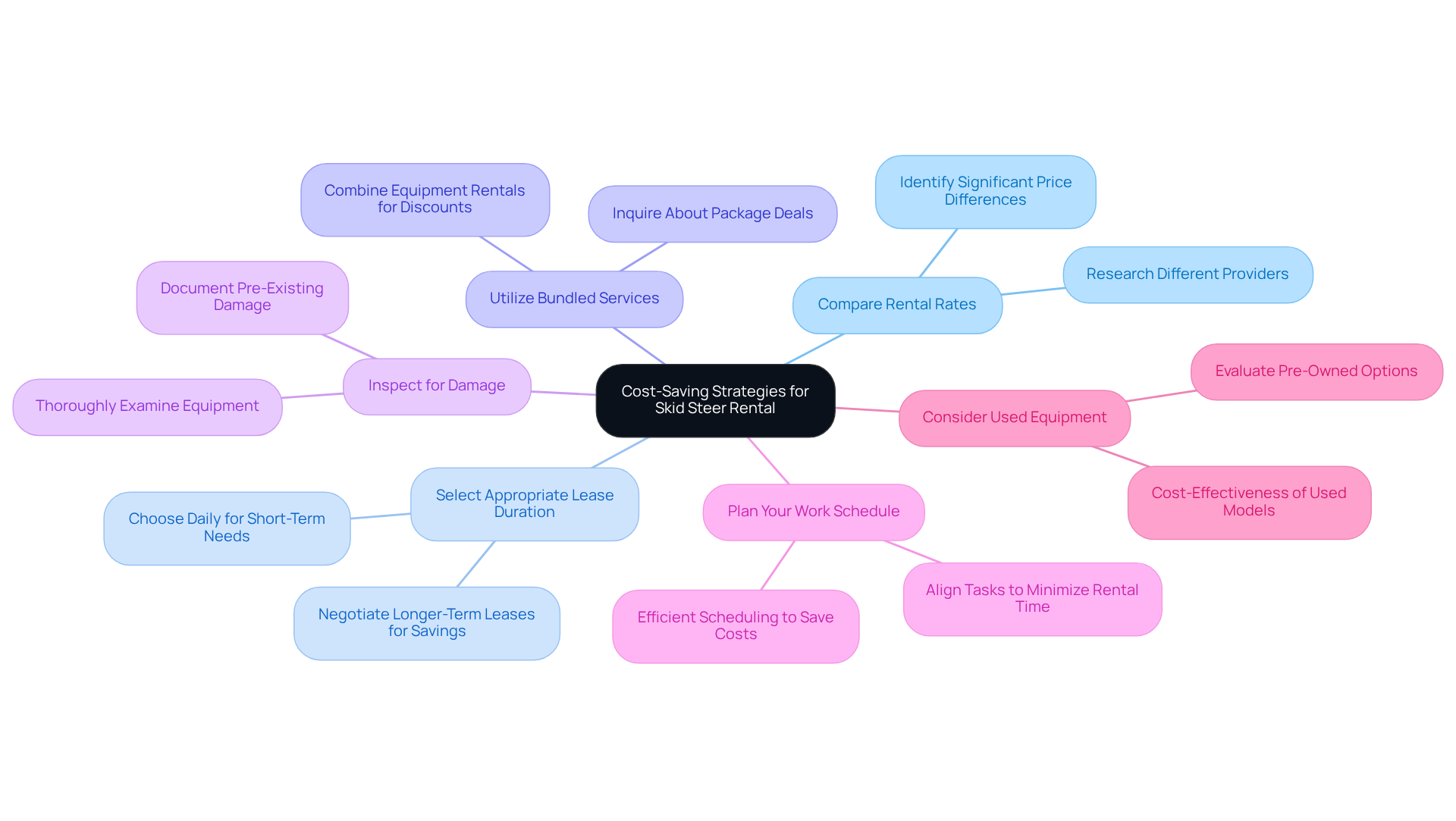Overview
This article serves as a comprehensive guide for project managers seeking to rent a skid steer, outlining essential steps to ensure an effective rental experience. It emphasizes the necessity of evaluating project needs, conducting thorough research on local providers, and grasping the intricacies of lease terms. Key considerations are detailed, including:
- Operating capacity
- Equipment inspections
- Cost-saving strategies
These elements collectively empower project managers to navigate the rental process adeptly, facilitating informed decision-making that aligns with their project requirements.
Key Highlights:
- Compact loaders, or skid steers, are used for tasks like excavation, grading, and material handling.
- Operating capacity for skid loaders in 2025 is projected to be 1,750 to 2,200 pounds.
- Skid steers can be wheeled for manoeuvrability or tracked for better traction on uneven terrain.
- Familiarity with lease conditions, including rates and extra charges, is crucial for budgeting.
- The skid steer leasing market grew at a rate of 3.3% from 2018 to 2022, indicating rising demand.
- Routine maintenance inspections are necessary to keep rented equipment in optimal condition.
- Evaluate project requirements to select the appropriate skid steer and attachments.
- Research local equipment providers like EZ Equipment Rental for quality and reliability.
- Inspect equipment for damage before finalising the lease to avoid unexpected fees.
- Cost-saving strategies include comparing rates, selecting appropriate lease durations, and planning work schedules efficiently.
Introduction
Navigating the world of skid steer rentals presents a significant challenge for project managers, given the vast array of options and terminology involved. It is essential to grasp key concepts such as operating capacity, lease conditions, and maintenance requirements to make informed decisions that enhance project efficiency.
With the increasing demand and potential pitfalls in the rental process, how can one ensure they secure the best equipment at the right price? This guide seeks to clarify the skid steer rental process, offering essential steps and cost-saving strategies that will empower project managers to approach their projects with confidence.
Understand Skid Steer Rentals: Key Concepts and Terminology
Before engaging in the rental process, understanding key concepts related to compact loaders is essential. Compact loaders are versatile machines utilized for various tasks, including excavation, grading, and material handling. Familiarizing yourself with the following important terms will significantly enhance your rental experience:
- Operating Capacity: This refers to the maximum weight a skid steer can safely lift and carry. In 2025, the average operating capacity of skid loaders is projected to be around 1,750 to 2,200 pounds, depending on the model. Grasping this range aids in choosing the appropriate model for your endeavor.
- Attachments: Skid loaders can be equipped with a variety of attachments, such as buckets, forks, and augers, to enhance their functionality. Knowing which attachments you might need is vital for your project, as they can significantly improve efficiency and versatility on the job site.
- Track vs. Wheel: Skid loaders come in two main types: wheeled and tracked. Wheeled models are more maneuverable on solid surfaces, while tracked models provide better traction on uneven terrain, making them suitable for diverse applications.
- Lease Conditions: Acquaint yourself with typical leasing terms, such as daily, weekly, and monthly rates, along with any extra charges for delivery or insurance. Understanding these terms will help you budget effectively and also guide you on where to rent a skid steer to avoid unexpected costs.
- Market Insights: The skid steer leasing market has displayed a historic growth rate of 3.3% from 2018 to 2022, indicating stability and rising demand for these machines. This context can be beneficial when considering leasing options.
- Maintenance Considerations: Routine maintenance inspections are essential to guarantee that the equipment stays in optimal working order during the leasing period, avoiding possible problems that could affect your work.
- Flexible Leasing Options: EZ Equipment Rental provides adaptable leasing terms and competitive pricing, simplifying your access to the equipment you require without financial burden.
By grasping these concepts, you will be better equipped to navigate the rental process effectively, including understanding where to rent a skid steer to ensure you select the right equipment for your project needs.

Follow the Step-by-Step Rental Process: From Needs Assessment to Equipment Return
To successfully rent a skid steer, follow these essential steps:
- Evaluate Your Requirements: Clearly outline the specific tasks for which you need the compact loader, including the type of work, anticipated duration, and any essential attachments. Understanding your project requirements is crucial for ensuring you select the right equipment.
- Research equipment providers in your area, such as , which is known for its extensive variety of compact vehicles and attachments, to find out where to rent a skid steer. Project managers emphasize the significance of investigating leasing firms to guarantee quality and reliability in equipment.
- Check Availability: Reach out to EZ Equipment Rental to confirm where to rent a skid steer model that aligns with your project timeline. Given the increasing demand for , timely communication is essential to secure the equipment you need.
- Review Lease Terms: Carefully examine the lease agreement, paying close attention to costs, insurance options, and any additional fees. Comprehending these terms can help prevent unforeseen expenses and ensure a seamless leasing experience.
- Examine the Equipment: Before finalizing the lease, inspect the skid steer for any signs of damage or maintenance issues. Ensuring the equipment is in good working order is vital for both efficiency and safety on the job site.
- Finalize the lease agreement by completing the necessary documentation and providing information about your project, particularly when considering where to rent a skid steer and verifying the lease period. This step is crucial for establishing clear expectations between you and EZ Equipment Rental.
- Receive the Equipment: Organize the collection or delivery of the loader, ensuring you have suitable transport if you choose to retrieve it yourself. Proper logistics planning can save valuable time and resources.
- Return the Equipment: After completing your assignment, return the machinery according to the lease agreement, ensuring it is clean and in the same condition as when received. Adhering to these guidelines helps maintain a positive relationship with EZ Equipment Rental for your future needs.
By following these steps, you can streamline the leasing process and ensure you have the right equipment to meet your project demands effectively. For immediate assistance, contact EZ Equipment Rental today!

Explore Cost-Saving Strategies: Maximize Value in Your Skid Steer Rental
To maximize value in your skid steer rental, consider the following cost-saving strategies:
- Compare Rental Rates: Don’t settle for the first rental quote. Research indicates that understanding where to rent a skid steer and conducting diligent comparisons can lead to reduced leasing costs, as prices can differ significantly among providers. Renting a compact loader for one day usually costs approximately $300; thus, comparing rates from various companies can reveal considerable savings.
- Select the Appropriate Lease Duration: If you only require the skid steer for a brief time, choose a daily option instead of a weekly or monthly rate. Conversely, if you need it for a prolonged duration, negotiating a longer-term lease can result in better pricing.
- Utilize Bundled Services: Some leasing companies provide discounts for combining equipment rentals. If your project requires multiple pieces of equipment, inquire about package deals and where to rent a skid steer to reduce overall costs.
- Inspect for Damage: Before completing your lease, thoroughly examine the equipment and record any pre-existing damage. This precaution helps avoid unforeseen fees when returning the equipment.
- Plan Your Work Schedule: Efficiently planning your work schedule can minimize rental time. The less time you need the skid steer, the more you save, making it crucial to align your tasks effectively.
- Consider Used Equipment: If your task permits, think about renting pre-owned equipment, which can frequently be more economical than new models while still fulfilling your requirements.
By implementing these strategies, you can effectively manage your rental costs and ensure that your project remains within budget. As David Bach emphasizes, "What determines your wealth is not how much you make but how much you keep of what you make," making it essential to adopt these cost-saving measures.

Conclusion
Understanding the intricacies of skid steer rentals is crucial for project managers aiming to optimize their equipment usage. Familiarizing oneself with essential terminology, following a structured rental process, and implementing cost-saving strategies enables project managers to select the right skid steer for their specific needs while managing expenses effectively.
Key concepts include:
- Operating capacity
- The significance of attachments
- The differences between wheeled and tracked models
The article outlines a step-by-step rental process, from evaluating project requirements to returning the equipment, emphasizing the importance of thorough research and communication with rental providers like EZ Equipment Rental. Furthermore, practical strategies for maximizing value, including:
- Comparing rental rates
- Selecting the appropriate lease duration
These empower managers to make informed decisions that align with their budgets.
Ultimately, effectively navigating the skid steer rental landscape enhances project efficiency and contributes to overall cost management. By applying the insights shared, project managers can approach their equipment needs with confidence, ensuring they are well-equipped to tackle their tasks while maximizing the value of their rental investments. Embracing these strategies will lead to more successful project outcomes and a stronger foundation for future endeavors.
Frequently Asked Questions
What is a skid steer and what are its main uses?
A skid steer is a versatile compact loader used for various tasks, including excavation, grading, and material handling.
What does "operating capacity" mean in relation to skid steers?
Operating capacity refers to the maximum weight a skid steer can safely lift and carry. In 2025, the average operating capacity is projected to be around 1,750 to 2,200 pounds, depending on the model.
What types of attachments can be used with skid loaders?
Skid loaders can be equipped with various attachments such as buckets, forks, and augers to enhance their functionality and improve efficiency on the job site.
What are the differences between wheeled and tracked skid loaders?
Wheeled skid loaders are more maneuverable on solid surfaces, while tracked models provide better traction on uneven terrain, making them suitable for diverse applications.
What should I know about lease conditions when renting a skid steer?
It is important to understand typical leasing terms, such as daily, weekly, and monthly rates, as well as any extra charges for delivery or insurance, to help budget effectively and avoid unexpected costs.
What is the current trend in the skid steer leasing market?
The skid steer leasing market has shown a historic growth rate of 3.3% from 2018 to 2022, indicating stability and rising demand for these machines.
Why are maintenance considerations important when renting a skid steer?
Routine maintenance inspections are essential to ensure that the equipment remains in optimal working order during the leasing period, avoiding potential problems that could affect your work.
What flexible leasing options are available for skid steers?
EZ Equipment Rental offers adaptable leasing terms and competitive pricing, making it easier to access the equipment needed without financial burden.




